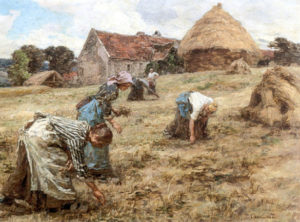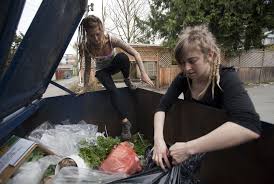By Thomas Parker (Regular Contributor)
In 2000, the French movie director Agnès Varda brought attention to the tradition of gleaning with her documentary The Gleaners and I. Gleaning (glanage), or collecting the edible leftovers from a farmer’s field after the harvest, has been permitted by law in France since 1554 and remains on the books today.

The Gleaners (1898)- Léon-Augustin l’Hermite
Gleaning takes place a day or two after the harvest and before the farmer lets the animals in the fields to graze or forage, placing the gleaner symbolically between civilized society and the animal world. The original law stipulated that only women, children, the old, sick, and destitute could participate, and that no tools (rakes, shovels, shears, etc.) be used. Tools separated “harvesting” from gleaning, implying the wielder’s agency and mastery of the land.
Instead, the gleaner humbly submitted to nature, the landholder, and society in general, passively receiving their generosity. As Varda put it, the gleaner is perpetually observed bending down toward the earth. A sort of symbolic submission.
Gleaning was authorized only in non-fenced-in fields from dawn until dusk, providing transparency that nothing illegal was taking place. In England, where the practice was also common, a bell rang in the opening and ending of the gleaner’s day. Along with being tightly framed in time and place, gleaning was defined in clear moral and philosophical terms. The Old Testament, often cited with regard to gleaning, observes “When you’re harvesting your field, if you forget a sheaf, don’t go back out into the field to get it. Let the foreigners, orphans, and widows take it. If you do this, the Eternal your God will bless everything you do” (Deuteronomy, 24:19). In France, gleaning was so much construed as a right bestowed by natural law that hiring a third party to gather what the harvest had overlooked, and thereby depriving the gleaner, was considered immoral if not illegal.

Les Glaneuses (1857)- Jean-François Millet
But as time went by, the gleaner’s role in society did not remain so clear-cut. In 1857, the artist Jean-François Millet unveiled a large painting that shocked the Parisian viewing public. It portrayed three women gleaners foregrounded in epic proportions normally reserved for heroic scenes. Notwithstanding their brazen placement on the canvas and their imposing physical size, the faces and the identities of the women remained obscured.
Moreover, despite their size, the women were depicted below the painting’s horizon in the bent posture described by Varda. The mix of the humble and the bold stirred emotions that were further exacerbated by the meager amounts gleaned by the women contrasted with the huge golden stores of harvested wheat overflowing in the background. A man on horseback supervised the harvest from above, completing the statement of societal inequity.
Tension beyond that of this provocative piece arose in other ways in the decades to follow. In the twentieth century, the mechanized world had a further effect on gleaning since the earliest machinery left inordinate amounts of produce in the fields. Farmers considered the gleaners of these copious leftovers as thieves, a stigma that remained even as machinery became more effective. Gleaning, once marked by its openness, was more and more viewed with a disapproving eye. Pushed increasingly out of the rural landscape, gleaning remained rampant in the urban cityscape, where it is now known as “freeganism” (or “récup” in French, from the word récupération).
In many cases, the diurnal licit practice of the country is a nocturnal illicit practice in the city. Instead of appearing as a normal sight in highly circumscribed parameters of time and place, gleaning has been pushed to the margins of alleyway supermarket rubbish bins. In some French communities, such as Nogent-sur-Marne, gleaning (or freeganism) has been outlawed with fines of 38 euros imposed on anyone breaking the law. The town government makes the argument that it is an unsanitary practice. But for many, gleaning remains rooted in the cultural consciousness as an undeniable right.

Freegans landing from above on a dumpster. Photo credit: Ben Nelms
Beyond what stories of freeganism and gleaning tell us about food waste, the transformation is interesting in symbolic terms. The gleaner no long appears as a gatherer, peacefully pecking at the ground, as in the Millet painting. Here the freegan seems more like a predator. Instead of melting into the landscape and conforming, she skulks through alleys, and pops up from the shadows, making off with all that has been stigmatized and rejected.
